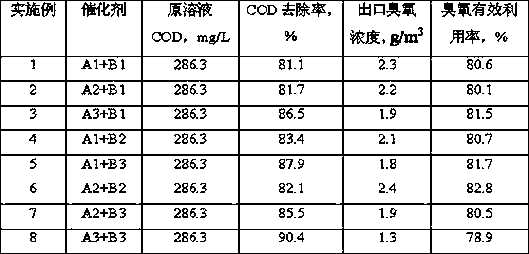Technology for treating organic wastewater through catalytic wet ozone oxidation
A technology of organic wastewater and ozone oxidation, which is applied in the fields of oxidized water/sewage treatment, special compound water treatment, water/sewage treatment, etc. It can solve the problem of low ozone utilization rate and achieve easy operation, high reactivity and stability in use. , The effect of the method and process is simple
- Summary
- Abstract
- Description
- Claims
- Application Information
AI Technical Summary
Problems solved by technology
Method used
Image
Examples
preparation example Construction
[0020] Preparation of Catalyst A1 (Fe / ZSM-5)
[0021] The diameter is 2.0mm, the specific surface area is 320m 2 / g, pore volume 0.3 cm 3 / g, the commercial ZSM-5 molecular sieve strip carrier with an average pore size of 2.4nm was dried at 120°C for later use. Weigh 500g of the ZSM-5 molecular sieve carrier, and use Fe(NO 3 ) 3 9H 2 O by Fe 2 o 3 Accounting for the ratio of 7.5% of the total weight of the catalyst to prepare a 1000mL solution. Impregnate the ZSM-5 carrier with an equal volume of this solution, stir in a constant temperature water bath at 60°C for 3 hours, let it stand in the air for 24 hours, and then evaporate it to dryness with a rotary evaporator at 80°C, and dry the obtained sample in a drying oven at 100°C. Then it was calcined in a muffle furnace at 550° C. for 4 hours, and the temperature was lowered to room temperature, and then taken out to obtain catalyst A1.
[0022] Preparation of Catalyst A2 (Cu-Ce / TS-1)
[0023] The diameter is 2.0mm, t...
Embodiment 1
[0033] The catalysts A1 and B1 are loaded into the cylindrical reactor according to the volume percentage of 50% and 50% respectively, and the total volume of the catalyst is 100cm 3 . Acid scarlet simulated dye wastewater (COD: 286.3 mg / L) enters the reactor from the bottom of the reactor at a rate of 200 mL / h, the residence time in the catalyst bed is 30 minutes, and the ozone concentration is 9.5 g / m 3 , at a rate of 400 mL / min, enters the bottom of the reactor together with the waste water. The reaction is carried out at normal temperature and pressure. After the reaction, the COD of the liquid is tested, and the catalyst activity is measured according to the removal rate of COD. The ozone concentration before and after the reactor is detected online with an ozone detector to calculate the effective utilization rate of ozone. The results are listed in Table 1.
Embodiment 2
[0035] Catalysts A2 and B1 were loaded into the reactor according to volume percentages of 40% and 60% respectively, and the reaction conditions were the same as in Example 1. The results are listed in Table 1.
PUM
| Property | Measurement | Unit |
|---|---|---|
| pore size | aaaaa | aaaaa |
| chemical oxygen demand (mass) | aaaaa | aaaaa |
| diameter | aaaaa | aaaaa |
Abstract
Description
Claims
Application Information
 Login to View More
Login to View More - R&D Engineer
- R&D Manager
- IP Professional
- Industry Leading Data Capabilities
- Powerful AI technology
- Patent DNA Extraction
Browse by: Latest US Patents, China's latest patents, Technical Efficacy Thesaurus, Application Domain, Technology Topic, Popular Technical Reports.
© 2024 PatSnap. All rights reserved.Legal|Privacy policy|Modern Slavery Act Transparency Statement|Sitemap|About US| Contact US: help@patsnap.com










